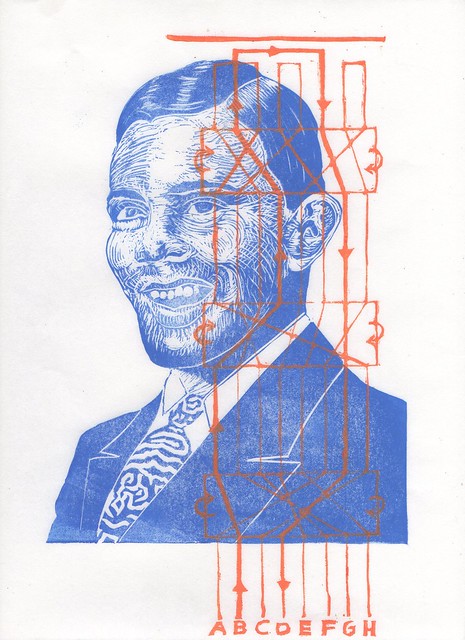
This is a linocut portrait of Alan Turing (1912-1954). It is printed in indigo and orange by hand on lovely Japanese kozo (or mulberry paper), 9.25" by 12.5" (23.5 cm by 32 cm) in an edition of eight.
This year we celebrate the centenary anniversary of Alan Mathison Turing, OBE, FRS (23 June 1912 – 7 June 1954), British mathematician, cryptanalyst, computer scientist, prophet and hero. He is someone I've long thought to portray, but I have been stumped. My scientists are shown with images of something quintessential to their science, or the reason they are famous (or should be), but Turing had so many accomplishments, it wasn't obvious what to portray or how. You might recall his portrayal in Neal Stephenson's 'Cryptonomicon'. I was introduced to him many year ago by Douglas Hofstadter's 'Gödel, Escher, Bach'1. You may also be familiar with the Turing Test or at least its portrayal in Blade Runner. Turing foresaw not only that machines might quite likely develop the capacity to think (after all, our brains are only made of matter, and complex systems of neurons, which either fire or not, much like an electronic switch), but that we needed an objective, double-blind test to determine whether something/someone was able to think, as early as 1950, when most people were only dimly aware of the existence of any sort of computer. But Turing quite literally defined what we now mean by computation itself (with his concept of Turing Machines) back in 1936. During the WWII he worked as a codebreaker and invented the device which was finally able to crack the notorious German cryptographic Enigma machine (in its more complex later incarnation)! His work undoubtedly saved many lives, and today we recognize him as a genius and a hero. In my print, I've included a simplified diagram of the mechanism behind the Enigma with its rotors or scramblers which acted as monoalphabetic substitution ciphers, literally scrambling letters at each turn. During, his all too short life, he also made important contributions to mathematical biology and explaining morphogenesis (the biological process that causes an organism to develop its shape) and the existence of Fibonacci numbers in biology. To indicate this later work, I've made the pattern of his tie look like the sort of Turing pattern produced by reaction–diffusion systems. This work presaged much later work in chaos theory.
Tragically, he lived in a time even more biased and bigoted than our own. Rather than recognizing the magnitude of his contributions to society during his lifetime, he was prosecuted for his homosexuality (still illegal in Britain in 1952) and forced to undergo chemical castration. He died two years later, after eating a cyanide-poisoned apple (determined by the coroner to be a suicide). It is truly abominable they way he was treated; while we can't address the past injustice we can remember, recognize and celebrate his remarkable achievements today.
There are many serious looking photos of Turing. I chose one of him smiling as inspiration for this portrait. He clearly enjoyed his work, and had a sense of humour (evident in the silly names he gave mathematical techniques he discovered)2, so I chose to remember him laughing.
1I cannot recommend this book strongly enough. Read it. Immediately, if not sooner.
2 i.e. Banburismus and Turingery









No comments:
Post a Comment